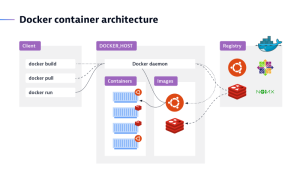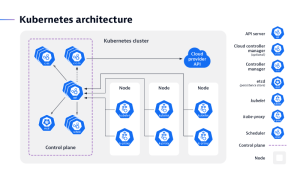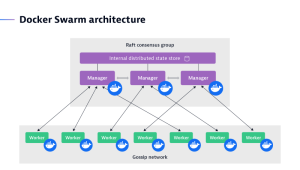If cloud-native technologies and containers are on your radar, chances are you’ve come across Docker and Kubernetes and wondering how they relate to each other. Is it Kubernetes vs Docker or Kubernetes and Docker, or both?
What’s the difference between Kubernetes and Docker?
Docker is a set of software development tools for creating, sharing, and running individual containers; Kubernetes is a system for operating containerized applications at scale.
Think of containers as standardized packaging for microservices with all the necessary application code and internal dependencies. Creating these containers is the domain of Docker. A container can run anywhere, on a laptop, in the cloud, on local servers, and even on edge devices.
A modern application consists of many containers. Operating them in production is the job of Kubernetes. Because containers are easy to replicate, applications can automatically scale: extend or contract processing capabilities to meet user demands.
Docker and Kubernetes
are mostly complementary technologies: Kubernetes and Docker. However, Docker also provides a system for operating containerized applications at scale, called Docker Swarm—Kubernetes vs Docker Swarm. Let’s unpack the ways Kubernetes and Docker complement each other and how they compete.
What is Docker?
Just as people use Xerox as short for paper copies and say “Google” instead of internet search, Docker has become synonymous with containers. However, Docker is more than containers.
Docker is a set of tools for developers to create, share, run, and containerize applications.
 In Docker
In DockerDevelopment tools for creating container images: Docker Build creates a container image, the blueprint for a container,
- which includes everything needed to run an application: application code, binaries, scripts, dependencies, configuration, environment variables, and so on. Docker Compose is a tool for defining and running multi-container applications. These tools integrate tightly with code repositories (such as GitHub) and continuous integration and continuous delivery (CI/CD) pipeline tools (such as Jenkins).
- Share images: Docker Hub is a registry service provided by Docker for searching and sharing container images with your team or the public. Docker Hub is similar in functionality to GitHub.
- Container Execution: Docker Engine is a container runtime that runs in almost any environment: Mac and Windows PCs, Linux and Windows servers, the cloud, and edge devices. Docker Engine is based on a top container, the main open source container runtime, a Cloud Native Computing Foundation (CNCF) project.
- Integrated container orchestration: Docker Swarm manages a cluster of Docker engines (typically on different nodes) called a swarm. This is where the overlay with Kubernetes begins.
What is Kubernetes
? Kubernetes is
an open source container orchestration platform for managing, automating, and scaling containerized applications. Kubernetes is the de facto standard for container orchestration due to its greater flexibility and ability to scale, although Docker Swarm is also an orchestration tool.

What is Kubernetes used for?
Organizations use Kubernetes to automate the deployment and management of containerized applications. Instead of individually managing each container in a cluster, a DevOps team can tell Kubernetes how to allocate the necessary resources upfront.
Where Kubernetes and the Docker suite intersect is in container orchestration. So when people talk about Kubernetes vs. Kubernetes. Docker, what they really mean is Kubernetes vs. Docker Swarm.
What are the challenges of container orchestration?
Although Docker Swarm and Kubernetes approach container orchestration a little differently, they face the same challenges. A modern application may consist of dozens or hundreds of containerized microservices that must work together seamlessly. They run on multiple host machines, called nodes. Connected nodes are known as clusters.
Hold this thought for a minute and visualize all these containers and nodes in your mind. It is immediately clear that there must be a number of mechanisms to coordinate such a distributed system. These mechanisms are often compared to a conductor conducting an orchestra to perform elaborate symphonies and juicy operas for our enjoyment. Trust me, orchestrating containers is more like herding cats than working with disciplined musicians (some claim it’s like herding Schrödinger’s cats). These are some of the tasks that orchestration platforms are challenged to perform.
- Container deployment. In the simplest terms, this means retrieving a container image from the repository and deploying it to a node. However, an orchestration platform does much more than this: it enables automatic recreation of failed containers, continuous deployments to avoid downtime for end users, as well as management of the entire container lifecycle.
- Scaling. This is one of the most important tasks that an orchestration platform performs. The “programmer” determines the location of the new containers so that computing resources are used in the most efficient way. Containers can be replicated or deleted on the fly to meet variable end-user traffic.
- Networks. Containerized services need to find and communicate with each other securely, which is not a trivial task given the dynamic nature of containers. In addition, some services, such as the front-end, must be exposed to end users and a load balancer is required to distribute traffic across multiple nodes.
- Observability. An orchestration platform needs to expose data about its internal states and activities in the form of logs, events, metrics, or transaction traces. This is essential for operators to understand the health and behavior of the container infrastructure, as well as the applications running on it.
- Security. Security is an area of growing concern for container management. An orchestration platform has several built-in mechanisms to prevent vulnerabilities, such as secure container deployment pipelines, encrypted network traffic, secret vaults, and more. However, these mechanisms alone are not enough, but require a comprehensive approach to DevSecOps.
With these challenges in mind, let’s take a closer look at the differences between
Kubernetes and Docker Swarm. Kubernetes vs Docker Swarm
Both Docker Swarm and Kubernetes are production-grade container orchestration platforms, although they have different strengths
. Docker
Swarm
,
also known as Docker in swarm mode, is the easiest orchestrator to deploy and manage. It can be a good fit for an organization that has just started using containers in production. Swarm solidly covers 80% of all use cases with 20% of Kubernetes complexity.

integrates seamlessly with the rest of the Docker toolset, such as Docker Compose and Docker CLI, providing a familiar user experience with a curve of Flat learning. As you’d expect from a Docker tool, Swarm runs anywhere Docker does and is considered secure by default and easier to fix than Kubernetes.
Kubernetes, or K8s for short, is the orchestration platform of choice for 88% of organizations. Initially developed by Google, it is now available in many distributions and is widely supported by all public cloud providers. Amazon Elastic Kubernetes Service, Microsoft Azure Kubernetes Service, and Google Kubernetes Platform each offer their own managed Kubernetes service. Other popular distributions include Red Hat OpenShift, Rancher/SUSE, VMWare Tanzu, IBM Cloud Kubernetes Services. This broad support avoids vendor lock-in and allows DevOps teams to focus on their own product instead of struggling with infrastructure idiosyncrasies.
The true power of Kubernetes comes with its scalability, configurability, and rich nearly limitless technology ecosystem that includes many open source frameworks for monitoring, management, and security.
<img src="https://dt-cdn.net/wp-content/uploads/2021/09/micro-graphic-kubernetes-vs.-docker-v1-4-300×170.png" alt=
“Kubernetes vs. Docker Swarm” /> Docker and Kubernetes: Better Together Simply put, the
Docker suite and Kubernetes
are technologies with different scopes. You can use Docker without Kubernetes and vice versa, however, they work well together.
From the perspective of a software development cycle, Docker’s territory is development. This includes configuring, creating, and distributing containers using CI/CD pipelines and DockerHub as image registration. On the other hand, Kubernetes shines in operations, allowing you to use your existing Docker containers while addressing the complexities of deployment, networking, scaling, and monitoring.
Although Docker Swarm is an alternative in this domain, Kubernetes is the best choice when it comes to orchestrating large distributed applications with hundreds of connected microservices, including databases, secrets, and external dependencies.
How does advanced observability benefit Kubernetes and Docker Swarm?
Whether you’re using Kubernetes or Docker Swarm, or both, managing clusters at scale comes with unique challenges, especially when it comes to observability. Both application teams and Kubernetes/Swarm platform operators rely on detailed monitoring data. Here are some examples.
 Kubernetes
Kubernetes
provides some very basic monitoring capabilities, such as event logs and CPU loads, for example. However, there are a growing number of open source and open standard technologies available to augment the built-in features of Kubernetes. Some frequently used observability tools include: Promtail, Fluentbit, and Fluentd for records; Prometheus for metrics; and OpenTelemetry for follow-ups, to name a few.
Dynatrace integrates with all these tools and more, and aggregates your own high-fidelity data to create a single, real-time entity model. This unique capability enables Dynatrace to provide advanced analytics, AI-driven root cause analysis, and intelligent automation, providing application teams and platform operators with a unified view of the entire technology stack.
